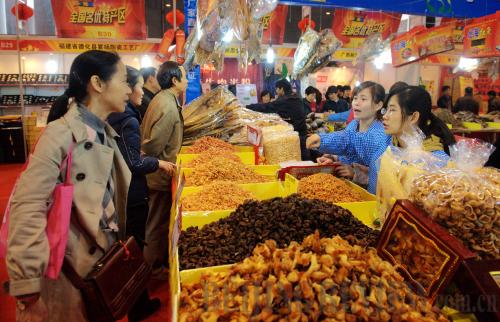|
 |
|
GETTING READY: Residents purchase dried goods for the coming Spring Festival holiday (February 9-15) at a food fair held in Nanning, southwest China's Guangxi Zhuang Autonomous Region (ZHANG AILIN) |
Boosting Mergers
The government has revealed specific requirements that are intended to increase mergers in nine sectors, the Ministry of Industry and Information Technology (MIIT) said on January 22.
The MIIT said the government is encouraging mergers in the automaking, steel, cement, shipbuilding, electrolytic aluminum, rare earth, electronic information and pharmaceutical sectors.
The ministry said the government aims to incorporate scattered production capacity and upgrade industrial structures in order to increase the international competitiveness of enterprises.
The Central Economic Work Conference held in December 2012 saw a government pledge to adjust China's industrial structure and resolve overcapacity problems that have hobbled some sectors.
Banks Cut Charges
The government will lower bank card charges for businesses ranging from retailers to property developers in order to reduce their financial burdens and boost consumption.
The move will take effect on February 25 as part of government efforts to bring distribution costs down and expand demand, said the National Development and Reform Commission on January 21.
The cuts will save Chinese businesses about 4 billion yuan ($637 million) a year.
Under the new charging scheme, catering enterprises that use card transactions will see their bank service fees drop by 35.7 percent, while those paid by department stores and supermarkets will decrease 21.4 percent and 25.7 percent, respectively.
Other types of businesses that will benefit from the change include hotels, jewelry shops, property developers, automobile merchandisers, tourist agencies and gas stations.
Card transactions that take place at public hospitals and public schools will be exempt from bank and payment network service fees.
Individual consumers will also benefit from the move, as high card charges for businesses are sometimes passed on to buyers in the form of higher product prices.
Investing in Taiwan
Capital flowing from the Chinese mainland into Taiwan increased by 650.11 percent in 2012 to reach $328 million, according to statistics released by Taiwan's economic authorities on January 21.
A total of 138 projects funded by mainland capital were approved by the island's economic authorities in 2012, an increase of 35.29 percent.
Major projects funded by mainland capital included the establishment of Bank of China and Bank of Communications branches in Taiwan.
Since mainland capital was allowed to enter the island on June 30, 2009, 342 investment projects have been approved, the authorities said.
| 